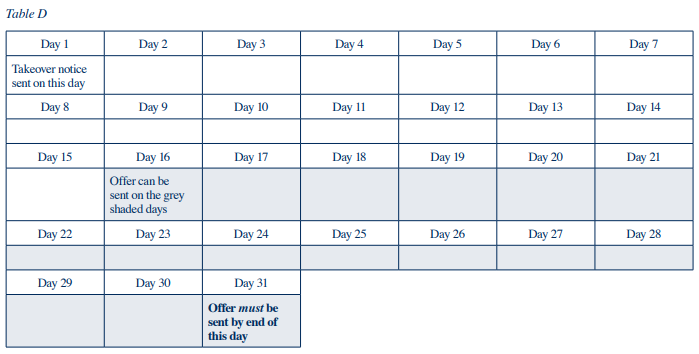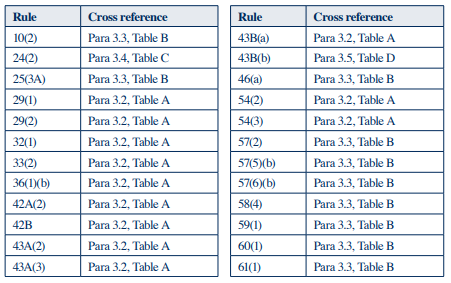Guidance Note – Timing Rules in the Code
Published 1 July 2010
-
Introduction
- The purpose of this guidance note is to advise market participants on the Panel’s interpretation and application of the rules in the Code that relate to time.
- A party to a Code-regulated transaction must observe all applicable time limits that are prescribed in the Code. If a party takes some action that is out of time, that action may be invalid or likely to result in a breach of the Code.
- All of the timing rules in the Code relate to takeover offers. The Companies Act 1993 contains the timing rules that relate to the holding of shareholder meetings for rules 7(c) and 7(d) of the Code.
-
The Law
- Section 35 of the Interpretation Act 1999 prescribes general rules of interpretation for statutory and regulatory timing provisions.
- Section 35 provides that:
(1) A period of time described as beginning at, on, or with a specified day, act, or event includes that day or the day of the act or event.
(2) A period of time described as beginning from or after a specified day, act, or event does not include that day or the day of the act or event.
(3) A period of time described as ending by, on, or with, or as continuing to or until, a specified day, act, or event includes that day or the day of the act or event.
(4) A period of time described as ending before a specified day, act, or event does not include that day or the day of the act or event.
(5) A reference to a number of days between 2 events does not include the days on which the events happened. - In T v J,[1] a full High Court decision, Robertson and Potter JJ gave guidance on the interpretation of statutory timing provisions. The Court noted that, as a general rule, fractions of a day ought to be disregarded from the calculation of timing provisions, to avoid uncertainty. Accordingly, the Court considered that in relation to a time period specified in a statute the whole of the first day of the specified period should be either included or it should be excluded.[2] The Court also observed that the general rule (i.e. disregarding fractions of a day) applies at the end of a specified time period: “the period ends at the termination of the day on which the terminating event occurs.”[3]
- In Forster v Jododex Aust Pty Ltd,[4] the High Court of Australia held that the phrase “not later than” indicates that a clear or full period of time must expire between two events, unless the context or the subject matter provides for a contrary intention.
-
The Panel’s approach to the timing rules in the Code
- The timing rules in the Code must be interpreted and applied in accordance with section 35 of the Interpretation Act and in light of any relevant case law.
- Where a period of time is expressed as being “not later than” or “at least” x days between two acts or events, the day of the act or event which triggers the time period and the day on which the required act is to be done are excluded from the time period.
Example – Rule 42A(2) – “not later than…”
Not later than 2 days after receiving a takeover notice, the target company must send the offeror a class notice.
Two whole days may lapse between the day the takeover notice is received and the day on which the target sends the class notice. The application of the rule may be illustrated in Table A (the shaded areas represent the timeframe specified in the rule):
- Where a period of time is expressed as being “within” x days of or after an act or event, the day on which the act or event occurs is excluded from the specified time period but the day on or by which the thing is to be done is included in the specified time period. }
Example – Rule 10(2) – “within…”
A target company, or its agent, that receives an approval or objection before the expiration of the offer period must, if requested by the offeror, send a copy of the approval or objection to the offeror within 2 days of its receipt.
The target company must, before the completion of two days after it receives the request from the offeror, send a copy of the approval or objection. The application of the rule may be illustrated in Table B:
- Where a period of time is expressed as commencing with an act or event, or ending with an act or event, the specified time period includes the days of those acts or events.
Example – Rule 24(2) – “with…”
The offer period must-
(a) commence with the date of the offer; and
(b) be not shorter than 30 days, and not longer than 90 days.
The specified time period begins on the same day as the date of the offer. It must be no shorter than 30 days including the date of the offer. It must end on the day that is not longer than 90 days including the date of the offer. The application of the rule may be illustrated in Table C:
- Where a period of time is expressed as “during the period beginning/ending x days after” an act or event, the day on which the act or event occurs is excluded from the specified time and so is the earliest day on or by which the thing may be done. However, the last day of the period within which the thing must be done is included in the specified time period.
Example – Rule 43B(b) – “during the period beginning 14 days, and ending 30 days, after…” The offeror must send the offer to the offerees on a date that is
(b)during the period beginning 14 days, and ending 30 days, after the takeover notice relating to the offer has been sent to the target company.
The offeror must leave 14 clear days after the day on which the takeover notice was sent before it may send the offer to the offerees. The offer must be sent within 30 days after the takeover notice was sent. The application of the rule may be illustrated in Table D:
-
More illustrations of the application of timing rules
- The tables set out below illustrate how some of the Code’s other timing rules apply. It is not an exhaustive list. It aims to provide guidance in accordance with the Panel’s approach to the application of the timing rules in the Code.
Rule 29(1) – “not less than/later than…days before…”
An offer may not be varied, and a variation notice may not be sent, later than 14 days before the end of the offer period
Rule 29(2) – “at least…days after…”
The offer must remain open for at least 14 days after a variation notice has been sent
Rule 34(1)(b) – “after x days…”
(1) If the consideration is not sent within the period specified in the offer to any person whose securities are taken up under the offer, the person may withdraw acceptance of the offer –
(a) by notice in writing to the offeror; but only
(b) after the expiration of 7 days’ written notice to the offeror of the person’s intention to do so.
(2) However, the right to withdraw acceptance of the offer does not apply if the person receives the consideration during the 7-day period referred to in subclause (1)(b).
Rule 43B(a) – “days after”
The offeror must send the offer to the offerees on a date that is
(a) no later than 3 days after the date of the offer specified under rule 44(1)(c)…
Rule 60(1) – “within … days…”
If an outstanding security holder returns to the dominant owner the documents referred to in rule 59 [i.e., the documents that are necessary to enable the dominant owner to be registered as the holder of the securities belonging to the outstanding security holder], the dominant owner must, within 7 days after the dominant owner receives those documents, send to the outstanding security holder –
(a) the consideration specified in the acquisitions notice; or
(b) if rule 56A applies [i.e. an alternative consideration], the consideration that is payable under that rule.
Reference Chart
The chart below sets out each of the timing rules in the Code and refers to the corresponding paragraph and Tables in the Guidance Note which illustrate the application of the particular rule:
- The tables set out below illustrate how some of the Code’s other timing rules apply. It is not an exhaustive list. It aims to provide guidance in accordance with the Panel’s approach to the application of the timing rules in the Code.
-
Days that are not working days
- Rule 3(2) of the Code provides:
If, under this Code, the time within which or the day on which any thing is to be done expires or falls on a day other than a working day as defined in section 2 of the Companies Act 1993,[5] the time so limited is extended to, and such thing may be done, on the next day that is a working day as so defined. - The purpose of rule 3(2) is to ensure that Code-regulated transactions are carried out under normal business conditions. Rule 3(2) varies a time period prescribed in the Code if that period would otherwise require a person to do something on a non-working day.
- The phrase “anything is to be done”, in light of the purpose of rule 3(2) and the context in which the words appear, refers to an instance where a party is under a legal obligation, imposed by the Code, to do something.
- Accordingly, rule 3(2) does not apply to things to be done by an offeree under a takeover offer, or an acquirer (for the purposes of rule 7(c)), or an allottee (for the purposes of rule 7(d)). While these parties may be bound by private contractual obligations relating to timing, there are no Code rules that put timing obligations on any of these parties. Rule 59 permits an outstanding security holder under a compulsory acquisition to return their instrument of transfer within 21 days to be eligible to receive the consideration from the dominant owner within 7 days. See paragraphs 5.7 and following, below, for a description of how the Interpretation Act extends the time limitation that rule 59(1) imposes on offerees.
- Rule 3(2) can be relied upon by an offeror or a target company because those persons are under legal obligations imposed by the Code to do certain things in a certain time in relation to a Code-regulated transaction.
- The following test may assist if any uncertainty arises as to the application of rule 3(2):
- Does the relevant rule in the Code prescribe a mandatory deadline within which a party must do something (ie. is under a legal obligation to do that thing)?
- If so, does the deadline expire on a day that is not a working day (as defined in section 2 of the Companies Act 1993)?
- If so, the deadline is extended to the next day that is a working day and the affected party may do whatever the Code requires at any time up to and including that next working day.
- Rule 3(2) of the Code applies only to those under a legal obligation to do something. Section 35(6) of the Interpretation Act has a broader application, and the context of the Code does not require that section 35(6) should not apply.
- Section 35(6) of the Interpretation Act provides:
“A thing that, under an enactment, must or may be done on a particular day or within a limited period of time may, if that day or the last day of that period is not a working day, be done on the next working day.” - There is one rule, 59(1), where section 35(6) of the Interpretation Act may apply. Rule 59(1) of the Code provides:
“An outstanding security holder who receives an acquisition notice accompanied by an instrument of transfer may, within 21 days after the date on which the acquisition notice is sent, return to the dominant owner, at the address specified in the acquisition notice, the duly executed instrument of transfer along with any other documents that are necessary to enable the dominant owner to be registered as the holder of the securities belonging to the outstanding security holder.” - By applying section 35(6) of the Interpretation Act to rule 59(1), if the final day on which the outstanding security holder may send the executed instrument of transfer falls on a non-working day, section 35(6) will extend the period to the next day that is a working day. So, although rule 3(2) of the Code does not address this situation, section 35(6) means that an outstanding security holder can, if the day that is 21 days after the date on which an acquisition notice is sent, is not a working day, return their instrument of transfer on the next day that is a working day.
- Paragraph 3.3 and Table B provide an illustration of the application of the timing in rule 59(1). Day 1 in the Table would be the day an acquisition notice is received; the shaded boxes would include up to Day 21. The instrument of transfer would be required to be returned on Day 22 at the latest. If Day 22 was not a working day, the outstanding security holder may return the executed instrument of transfer on the next day that was a working day.
- Rule 3(2) of the Code provides:
Footnotes:
[1] [2000] 2 NZLR 236.
[2] Ibid, paragraph 20.
[3] Ibid, paragraph 20.
[4] (1972) 127 CLR 421.
[5] “Working day means a day of the week other than –
(a) Saturday, Sunday, Good Friday, Easter Monday, Anzac Day, the Sovereign’s Birthday, Labour Day, and Waitangi Day; and
(b) A day in the period commencing with the 25th day of December in any year and ending with the 2nd day of January in the following year; and
(c) If the 1st day of January in any year falls on a Friday, the following Monday; and
(d) If the 1st day of January in any year falls on a Saturday or a Sunday, the following Monday and Tuesday.”



